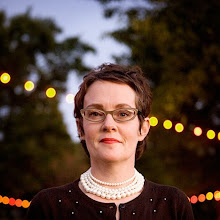
Bookmark from Housing Works Bookstore Cafe, an AIDS-support organization in New York.
What is the future of museums? What about non-profits in general, from health care and social services to micro-loans for veterans? How will museums stack up against social organizations as the economy continues to reform itself? These are urgent questions--now where to find the answers?
I was recently accepted into the Nonprofit Services Center's Women's Leadership Academy for Executive Directors. I got notice just a week before the Academy started--evidently I'm the first arts person to participate and finding an underwriter was tough. (An aside: the Arts and Education Council will henceforth sponsor an arts leader--a great boost for our team!) Through the Women's Academy I have met a woman who started her non-profit using running to build confidence in girls and a woman who organizes small business loans for returning veterans. The group presents an impressive array of talents and passions dedicated to making the region better.
Despite the diversity of the non-profits in this year's Academy, our problems are very similar, but it's clear that we in the arts need to speak differently.
We've tried touting the uplifting, unquantifiable benefits of culture for social growth as our defense. We've tracked numbers to demonstrate our value as an education / entertainment outlet. We've generated economic impact numbers to show our contributions to society's health. What else can the arts do to defend themselves in this economy?

Director's Forum panel "Investing in Consultant: The Value of an Objective Perspective", left to right: Kevin Grogan, The Morris Museum; Lisbeth Mark, Jeanne Collins & Associates; Susan Kreeger, Real HR Solutions; Shirley Ferguson Jenks, Jenks Group; Richard W. Franklin, Exhibits Coalition.
In addition to the conversations I've been having at the Nonprofit Services Center meetings, this past week I attended a Director's Forum run by the Art Museum Partnership, based in New York. The title of the program was "Survival Strategies for the Recession-Weary Leader."
While I'm not sure the conference stuck closely to the overarching topic, and we didn't share new fund-raising secrets, I did learn some interesting / shocking things:
1. The Association of Art Museum Directors estimates that 75% of current museum directors will retire within 10 years. As a result AAMD is instituting its own training programs.
AAMD has been behind the eight ball on this; museum directors and curators from smaller organizations have turned recently to the management programs at Columbia University and the Getty to gain expertise and mentoring. I suspect the AAMD's program may cut into these existing programs as a way to keep itself relevant to the field.
2. AAMD is (finally) opening up its membership beyond 200, which made it exclusive and exclusionary, to allow organizations with budgets lower than today's floor of about $2.5 million.
What this said to me: It sounds like the AAMD recognizes a need to move into the 21st marketplace and diversify to younger leaders, women and minorities, and to consider how this next generation (myself included) will change the field. It's exciting that this group is shaking itself up to address the pressing needs seen and felt across the field. AAMD walks a fine line between support and advocacy, but they need to take a more active leadership role on behalf of all of us.
3. Many museum boards hire a search firm to replace directors, and you are only considered for such posts if you are in the head-hunter's Rolodex (this from Becky Klein of Phillips Oppenheim.) What a shock: what of America's famed meritocracy? This was the most chilling fact.
In light of the AAMD's recognition of a crisis of succession it seems that head hunters need to broaden their own practice and allow for new candidates to break into the hallowed halls of museum practice. Perhaps this explains how conservative and homogeneous large museums have become--because the candidate pool is so small?

Sign on side of van in Chelsea area.
I saw this sign while touring galleries in Chelsea with some St. Louis friends after my conference was over, and somehow the discrepancy between "perfection" and scratched signage suggests the dilemma non-profits have in today's world.
How to meet a set of standards--both your own and the community's--when funds are fleeting and fickle? How can smaller arts organizations present world-class quality when they are barely heard above the cacophony of the marketplace? What, indeed, will we look like in 10 years when 75% of today's museum leaders retire? All compelling questions, I look forward to helping sort this out.




No comments:
Post a Comment